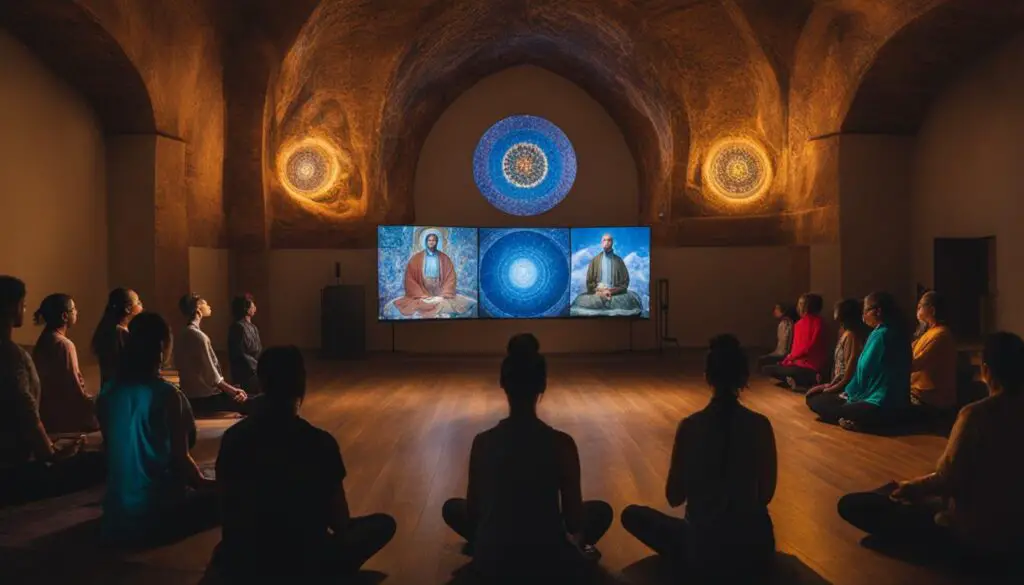Virtual religious communities have emerged as a powerful force in the digital age, offering a new way for people to connect and engage with their faith. As technology continues to advance, online religious groups, also known as digital faith communities, are becoming increasingly prevalent. Virtual religious services, accessible from anywhere with an internet connection, provide individuals with the opportunity to participate in worship and religious practices remotely.
This shift towards virtual religious communities has been accelerated by the COVID-19 pandemic, as many religious organizations have had to adapt to restrictions and find innovative ways to continue their services and connect with congregants. It is estimated that around 27% of U.S. adults regularly watch religious services online or on TV, highlighting the growing importance of virtual worship.
Key Takeaways:
- Virtual religious communities offer the convenience of accessing religious services and practices from anywhere with an internet connection.
- The COVID-19 pandemic has accelerated the adoption of virtual worship and the creation of digital faith communities.
- About 27% of U.S. adults regularly watch religious services online or on TV, indicating the growing popularity of virtual religious services.
- Virtual religious communities provide opportunities for individuals to connect, engage, and find support in their faith.
- As technology continues to advance, the future of virtual religious communities is likely to be a blend of virtual and in-person practices, catering to the diverse spiritual needs of individuals in the digital realm.
The Preferences of Attendees
When it comes to virtual religious practices, cyber religious gatherings, and remote worship, attendees have varying preferences. While the majority of Americans who attend services do so in person, there are several advantages to virtual worship that cannot be ignored. According to a survey, 43% of people who regularly watch services online or on TV cite convenience as the top reason for doing so.
With virtual religious gatherings, individuals can participate in worship services from the comfort of their own homes, allowing for flexibility in their schedules. They can also attend services that are held far away, bringing the opportunity to explore different spiritual communities and traditions. Additionally, virtual worship provides a way to keep up with a house of worship that attendees used to belong to, enabling them to stay connected to their faith.
Furthermore, remote worship has gained significance during the COVID-19 pandemic, as it allows individuals to avoid the risk of catching or spreading the virus. Many religious organizations quickly adapted to the online format to ensure the safety of their congregations, leading to an increased demand for virtual religious services.

As the image above illustrates, virtual religious practices provide individuals with the opportunity to gather and worship remotely, creating a sense of togetherness within their cyber religious communities. Whether due to convenience, accessibility, or safety concerns, virtual worship has emerged as a valuable option for attendees seeking to engage with their faith in a remote setting.
Connection and Participation in Virtual Worship
The shift to virtual worship has transformed the way individuals engage with their faith, offering new avenues for connection and participation. While attending religious services in person allows for a greater sense of connection with fellow worshippers, virtual viewers have found ways to actively participate, even from a distance.
A survey conducted by the Pew Research Center found that approximately two-thirds of Americans who attend religious services in person feel a strong connection with others in their congregation. This sense of connection is an integral part of the worship experience, fostering a supportive and uplifting atmosphere.
However, virtual viewers have also discovered ways to engage in worship rituals as if they were attending in person. According to the survey, 39% of those who watch religious services online or on TV say they still participate in acts such as praying or responding out loud. This shows that despite the physical barrier, many virtual viewers actively involve themselves in the worship experience.

While virtual worship provides convenience and accessibility, only 25% of virtual viewers feel like active participants in the services they watch. This highlights the importance of finding ways to bridge the gap between online and in-person experiences, creating a more immersive and engaging virtual worship environment.
Virtual religious communities, often referred to as cyber churches, are continuously exploring ways to enhance connection and participation in remote worship. By leveraging technology and innovative approaches, these communities strive to create a sense of togetherness and engagement that closely aligns with in-person worship.
The Rise of Virtual Worship During the Pandemic
The COVID-19 pandemic has brought about unprecedented changes in how we practice our faith. As restrictions on gathering and social distancing measures were implemented, religious communities faced the challenge of adapting their worship practices to the new normal. Many churches swiftly embraced technology and transitioned to virtual platforms to continue serving their congregations. This sudden shift gave rise to the online religious congregation, remote worship, and the emergence of digital spiritual communities.
Overnight, churches that were once hesitant or resistant to technology had to quickly learn how to navigate the digital landscape. Although this transition presented its fair share of challenges, such as the lack of necessary equipment and technical know-how among congregations, religious organizations rose to the occasion.
“The pandemic has forced us to explore new ways to connect with our community,” says Reverend Sarah Thompson of Grace Community Church. “We had to find innovative ways to foster connection and spiritual growth, even when we couldn’t physically come together.”
This period of adaptation has not only demonstrated the resilience of religious communities but has also created opportunities for the creation of digital spiritual communities. These communities have allowed individuals from different geographical locations to come together and worship remotely, forming connections that transcend physical boundaries.
“Digital spiritual communities provide a platform for individuals who may have felt isolated or disconnected in their faith,” explains Dr. Rachel Myers, a religious studies professor at the University of California. “It’s a space where people can seek support, engage in discussions, and find a sense of belonging.”

As the pandemic continues to shape our lives, the adoption of virtual worship has become a vital aspect of religious practices. Churches now livestream services, host online prayer groups, and facilitate virtual small group meetings. These adaptations have allowed religious communities to continue nurturing the faith of their members regardless of physical limitations. The unprecedented circumstances have fueled the growth of online religious communities and the exploration of new ways to connect with spirituality in the digital realm.
The next section explores the impact of virtual worship on the sense of community within religious organizations.
The Impact of Virtual Worship on Community
Virtual worship has revolutionized the way religious practices are carried out, allowing individuals to connect with their faith from the comfort of their own homes. Online religious groups and cyber religious gatherings have created digital faith communities, enabling people to participate in virtual religious practices while connecting with others from different geographical locations.
“Through virtual worship, we have the opportunity to come together as a diverse community of believers, transcending physical boundaries and fostering a sense of unity and shared purpose,” says Reverend Lisa Thompson of Sacred Sanctuary Church.
“Virtual worship has provided a platform for those who may have felt isolated or unable to attend traditional religious services. It is a space where people can find support, connection, and the strength to navigate their spiritual journey,”
However, while virtual worship has its advantages, it can also present challenges. While participating in online religious services, some individuals may feel a lack of emotional connection and a sense of detachment compared to in-person gatherings. The communal experience, the warmth of fellow worshippers, and the shared energy are often difficult to replicate virtually.
In order to mitigate these challenges and enhance communal engagement, religious communities are continuously finding innovative ways to adapt to the digital realm. Some churches have implemented virtual small group meetings, providing opportunities for interactive discussions and fostering a deeper sense of connection. Others have encouraged virtual worshippers to actively participate by joining online prayer groups and sharing their reflections during services.
Furthermore, the rise of digital faith communities has created spaces for individuals to engage in virtual fellowship and support one another. Online religious groups offer platforms for discussions, prayer requests, and the sharing of faith experiences. These communities provide a sense of belonging and solidarity for those who may not have access to physical religious congregations or who prefer to engage in virtual religious practices.
“While virtual worship may have its limitations, it is important to recognize the transformative power it holds in forging connections and providing spiritual sustenance in our modern world,” affirms Rabbi Sarah Cohen of Unity Synagogue.

Virtual worship has proven to be a powerful tool for maintaining and nurturing religious communities. While it may not fully replace the intimate experience of in-person gatherings, it offers a unique opportunity for individuals to connect with their faith and find support in the digital sphere. The future of virtual religious practices and digital faith communities is likely to continue evolving, blending seamlessly with traditional religious practices to cater to the diverse spiritual needs of individuals in our increasingly interconnected world.
Challenges and Opportunities for Virtual Worship
The transition to virtual worship has brought about both challenges and opportunities for religious communities. As churches strive to adapt to the digital landscape, they have faced the task of quickly acquiring the necessary technological skills and resources. Many have relied on volunteers and makeshift solutions, which can lead to burnout among pastors and other church leaders. However, amidst these challenges, the adoption of technology has opened up new avenues for reaching and engaging with congregations.
Livestreaming services have allowed religious organizations to extend their reach beyond physical limitations, enabling remote worship for individuals who may not have been able to attend in person. This has created opportunities for people to stay connected to their faith communities even when they are unable to physically gather. Additionally, online prayer groups and virtual small group meetings have provided spaces for congregants to come together, share their experiences, and support one another from a distance.
The long-term effects of these changes on the social and theological aspects of congregations are still being studied. However, it is evident that virtual worship has the potential to enhance accessibility and broaden the reach of religious congregations. By embracing technology and exploring innovative ways to foster connection and engagement, religious communities can continue to thrive amid changing times.

Challenges:
- Adapting to new technology and learning how to use it effectively
- Relying on volunteers and makeshift solutions, leading to burnout
- Ensuring meaningful connection and engagement in a virtual setting
Opportunities:
- Extending the reach of religious communities through livestreaming services
- Creating virtual spaces for prayer groups and small group meetings
- Enhancing accessibility and inclusivity for individuals who cannot physically attend services
The Future of Virtual Religious Communities
The COVID-19 pandemic has catapulted virtual religious services into the mainstream, prompting a digital transformation in the way faith communities connect and practice. While the full impact on the future of religious communities is yet to be determined, one thing is clear: technology will play an increasingly pivotal role.
As technology continues to advance and become more integrated into our daily lives, virtual religious services and digital faith communities are poised to become more prevalent.
Virtual religious services offer several advantages. They provide convenient access to worship, enabling individuals to participate in religious rituals and ceremonies from the comfort of their homes. Distance is no longer a barrier, as people can join online religious groups that are geographically distant. In addition, virtual religious services have proven to be a valuable alternative for those who wish to avoid the risk of catching or spreading COVID-19 and for individuals seeking to maintain a connection with a house of worship they used to belong to.
However, it’s important to note that virtual religious services cannot fully replace the sense of community and connection experienced during in-person worship. The physical presence of fellow worshippers, the shared rituals, and the collective energy contribute to a unique and irreplaceable experience. In-person worship and community gatherings will always hold a special place in religious practice.
The challenge for religious communities lies in finding a harmonious balance between virtual and in-person practices that best serve the spiritual needs of their members.
Virtual religious communities will likely continue to evolve as technology advances and congregations become more adept at leveraging digital platforms. The pandemic has accelerated the adoption of online religious groups and has demonstrated the potential for creating meaningful connections and fostering spiritual growth in the digital realm.
As we move forward, virtual religious services and digital faith communities should be viewed as complementary tools rather than replacements for traditional religious practices. The blending of virtual and in-person experiences can enhance accessibility, allow for greater flexibility, and create new opportunities for engagement, while also preserving the authenticity and depth of religious experiences.
Ultimately, the future of virtual religious communities will lie in striking a balance between the convenience and accessibility of the digital world, and the rich traditions and sense of community found in physical worship spaces.
Impact of Technology on Religious Practices and Beliefs
The use of technology has had a profound impact on religious practices and beliefs, ushering in a new era of virtual religious practices, cyber religious gatherings, and remote worship. With the advent of digital platforms and online communities, individuals now have greater accessibility and flexibility in engaging with their faith, regardless of geographical constraints or physical limitations.
Virtual religious practices have revolutionized the way people worship, allowing them to connect with their religion and community remotely. Through live streaming services, online prayer groups, and virtual religious congregations, individuals can participate in religious rituals and connect with like-minded believers from the comfort of their own homes.
However, the rise of virtual religious practices also raises questions and challenges regarding the authenticity and depth of religious experiences in a digital setting. Some may argue that true worship requires a physical presence and the tangible elements of a traditional religious gathering. Others may question the ability of virtual platforms to foster a sense of spiritual connection and intimacy.
The blending of online and offline religious experiences, often referred to as “digital religion,” is a growing field of study that seeks to understand the impact of technology on religious beliefs and practices. Scholars explore the ways in which technology shapes religious rituals, community dynamics, and the formation of personal beliefs in the digital age.
Table: Comparing Virtual and In-Person Religious Practices
| Virtual Religious Practices | In-Person Religious Practices |
|---|---|
| Convenience and accessibility | Physical presence and tangible experiences |
| Ability to join worship services remotely | Sense of connection and community |
| Diverse online religious communities | Traditional religious institutions |
| Flexibility in time and location | Shared rituals and traditions |
The impact of technology on religious practices and beliefs is a complex and multifaceted topic. While virtual religious practices offer convenience and inclusivity, they may not fully replicate the deep spiritual connections fostered through in-person interactions. It is essential for individuals, religious organizations, and scholars to engage in thoughtful discussions and explorations of the implications and meanings behind these evolving practices.
Conclusion
The rise of Virtual Religious Communities has ushered in a new era of connectivity and accessibility for individuals seeking to connect with their faith. Online religious groups, also known as digital faith communities, have become a platform for people to engage in virtual religious services and practices.
While virtual worship may present challenges and limitations, such as the lack of emotional connection and sense of community experienced in in-person services, it also offers unique advantages. Virtual religious services have provided an opportunity for individuals to participate in religious practices from the comfort of their own homes, connect with people from different geographical locations, and find support and community.
The future of Virtual Religious Communities is likely to embrace a blend of virtual and in-person practices, as religious organizations adapt to the changing technological landscape. By leveraging the power of technology, these communities aim to create inclusive and meaningful experiences that cater to the spiritual needs of individuals in the digital realm.
As Virtual Religious Communities continue to evolve, it is important to strike a balance between virtual and in-person engagement, ensuring that both forms of worship and community gathering are given space to thrive. Ultimately, the goal is to foster connection, provide support, and create transformative experiences that strengthen individuals’ faith in the digital age.
FAQ
What are virtual religious communities?
Virtual religious communities are online religious groups or digital faith communities that gather and engage in religious practices and services through virtual platforms.
What is the difference between virtual religious services and in-person services?
Virtual religious services are conducted online or through digital platforms, while in-person services are attended physically at a place of worship.
Why do people choose virtual religious practices?
People choose virtual religious practices for various reasons including convenience, the ability to attend services from far away, the need to avoid COVID-19 risks, and the desire to connect with a previous religious community.
Do virtual viewers feel connected to other worshippers?
While in-person attendees tend to feel a greater connection to fellow worshippers, some virtual viewers also report feeling a sense of connection through engaging in familiar religious practices.
What challenges did religious communities face in transitioning to virtual worship?
Religious communities faced challenges in adapting to technology, including lack of equipment and technical know-how, leading to burnout among church leaders.
What opportunities have arisen from virtual worship?
Virtual worship has provided new possibilities for livestreaming services, online prayer groups, and virtual small group meetings, allowing for greater engagement with congregations.
Will virtual religious communities become more prevalent in the future?
As technology continues to advance, virtual religious services and digital faith communities may become more prevalent, but physical worship and community gatherings will remain important.
How does technology impact religious practices and beliefs?
Technology allows for greater accessibility and flexibility in engaging with faith, but it also raises questions about the authenticity and depth of religious experiences in a virtual setting.
What is the future of virtual religious communities?
The future of virtual religious communities lies in finding a balance between virtual and in-person practices that best serve the spiritual needs of individuals.
Source Links
- https://www.pewresearch.org/religion/2023/06/02/americans-experiences-with-virtual-religious-services/
- https://brill.com/view/journals/rmdc/9/2/article-p165_165.xml
- https://liberalarts.tamu.edu/communication/2022/02/27/when-the-church-went-digital-professor-leads-research-on-the-rise-of-remote-worship/

